Our view at Stack - Simplify growth with an all-in-one platform. Powerful marketing, sales, and support automation. Integrated CMS. Scalable software. Crafted for customer experience.
Beth Goldowitz, who’s been managing nonprofit organizations for the past 20 years, says that when “managed correctly, grants can keep organizations afloat. They’re stable and predictable, a revenue stream that the organization can count on for the duration of a contract.”
But do you know how long it takes to write a single grant application?
Over 30 hours, and considering that grant writers usually get paid between $25 and $100 per hour, depending on their experience, it’s a significant cost. That’s why it’s so important for nonprofits to decide which grants to pick.
Your organization can make it much easier for applicants to assess if they’re the right fit for your project. It all comes down to getting your RFP for grants right, including adding the right sections and asking the right questions.
Before I dive deeper into the subject, let’s answer the question: what is an RFP for grants?
What is an RFP for grants?
The Challenges of Writing an RFP for Grants
The Anatomy of an RFP for Grants
How to Write an RFP for Grants
Best Practices for Writing an RFP for Grants
RFP for Grants Resources

What is an RFP for grants?
An RFP for grants, or Request for Proposals, is a document issued by grantors such as foundations and government agencies encouraging nonprofit organizations to submit proposals for funding.
Essentially, RFPs offer nonprofits an opportunity to secure funding for various initiatives, irrespective of whether they relate to education, healthcare, or environmental causes.
Each RFP is tailored to achieve a specific goal, so submitted proposals must be in line with the objectives outlined in the RFP.
The Challenges of Writing an RFP for Grants
I have spoken to a few people working at nonprofits to find out what challenges they came across, either while creating their own RFPs or preparing RFP proposals. Here are the most common obstacles.
Lack of Sufficient Information About the Procurement Process
The quality of your procurement process will impact the quality of the applications you receive. If you don’t share enough information about it, like the timeline, budget, selection criteria, etc., then two things might happen:
- You will receive applications that aren’t the right fit for the project.
- A lot of applicants who are the right fit won’t take part in the process as they’ll feel discouraged by the lack of clarity.
The more detailed and logical your procurement process is, the higher the chances of receiving high-quality proposals.
RFP Grants Failing to Communicate the Vision Clearly
This is an RFP grant challenge that has come up the most frequently.
Gauri Manglik, CEO and co-founder of Instrumentl, says that “many organizations struggle to articulate what specific issues they are trying to address and how the grant they offer will drive impact.”
What often happens is that RFP grant writers take a scattered approach instead of having a cohesive strategic framework. As a result, it’s hard for founders who give out grants to evaluate the proposal’s purpose and potential.
Manglik adds that “the most effective RFPs have a sharply defined focus outlining the goals, target population, and theory of change for proposed activities.”
Not Understanding the Legal Implications of the Grant
Grants often come with terms and conditions that must be followed to stay compliant. Failing to do so might result in penalties or even in grants being revoked.
These terms and conditions should be clear and easy to understand to minimize the risk of breaching them.
Jonathan Feniak, general counsel at LLC Attorney, says, “When writing RFP grant proposals, it’s crucial to understand the legal implications of the grant and factor any liabilities into your plan.
If any IP is developed with grant funding, you must specify ownership rights to avoid potential conflicts with donors later.”
Feniak also notes that proposals should clearly outline your expectations, and you must agree on whether the charity or the investor owns its rights.
“Generally, it’s best to consult your legal team throughout the RFP writing process to manage the risks and clearly outline IP ownership,” adds Feniak.
Ensuring clarity and specificity in the language used.
It’s vital to use a language that is not only clear but also specific so it’s easier for potential bidders to understand what’s expected of them. This applies to the requirements, objectives, and expectations of the project.
Kimberly Wall, co-founder of BibleKeeper, says, “The challenge lies in articulating the project’s goals, objectives, and expected outcomes clearly using words that are not really overwhelming the potential applicants with unnecessary details.”
Using the right language will eliminate confusion among nonprofits and make sure that their proposals accurately correspond to the needs of the RFP issuer.
The Anatomy of an RFP for Grants
RFPs for grants come in two forms: concise, short tables, where information is filled out in bullet points, and longer ones, which cover each section in detail.
The former aims to give a high-level overview, while the latter is where applicants take a deep dive into their proposal.
So, there isn’t such a thing as an “ideal” length for an RFP. These types of documents can take up multiple pages and usually function as downloadable PDFs.
If you’re wondering what elements grantors should include, then here’s an RFP structure we recommend at HubSpot.
RFP: [Project Name]
Proposal Due By: [Date]
[Organization Name]
In addition to the name, this section could also feature a short overview of your mission. Don’t include a long history of your organization. Instead, use this space to provide a bit of context on what it does and its target market.
Project Overview
A brief introduction to the project itself to let nonprofits know right away if it’s something worth bidding on — no longer than 1-2 paragraphs.
Project Goals
This section identifies what you hope to accomplish through assigning funds to relevant organizations. Specify what you’ll see as a “win” so everyone is on the same page.
Scope of Work
A description of the project and a scope of work — either detailed, if it’s a long RFP, or bullet points if it’s short.
Current Roadblocks and Barriers to Success
In this section, mention any potential constraints that could either disqualify certain candidates or increase the operational complexity of meeting goals.
Evaluation Metrics and Criteria
Here, you outline how you’re going to choose grantees. There are different approaches — some companies use simple “yes” or “no” evaluations to check if a proposal meets the project objectives.
Other organizations use percentages to score more important criteria higher than others.
Submission Requirements
Exact guidelines bidders must adhere to.
Project Due By
If there is a specific project delivery date, mention it in the RFP. This will help you filter out applicants who can’t guarantee completing it within the required timeline.
Budget
Here, you should include the target budget. Specify if this budget will be distributed among multiple organizations or assigned to a single grantee.
General Conditions of Contract
This could include information like:
- Applicant’s legal status.
- Your stance on subcontracting.
- Indemnification, insurance, and liabilities.
Some templates also suggest asking questions that you expect bidders to answer — these can serve as a way to further check their alignment with your mission.
How to Write an RFP for Grants
So, now that you know what goes into an RFP, let’s learn how to write them. Below, I’ll describe the steps you should take when tackling this paperwork.
In each section, I’ll work through the steps, as I build a mock RFP for sustainability nonprofits.
My sample organization, Earthly Partners, is looking to fund sustainability projects based in the Southwestern United States. Let’s get started.

1. Identify the objectives.
In this step, I want to list all the key information, like goals, timeline, budget, and applicant profile.
As you gather these, you’ll likely come across some informational gaps or considerations that require expert knowledge, like legal considerations and grantor/grantee obligations.
This is an important preliminary stage, which should end with a complete list of information you’ll need to evaluate bidders.
Testing It Out
So, what does my organization, Earthly Partners, want to accomplish? We want to focus on fighting climate change in the South West, particularly through drought relief and community advocacy.
We are able to provide grants of up to $50,000 to each nonprofit.
2. Write an introduction.
Now, I want to provide a bit of information about the organization and the area we focus on. I may also include my organization’s values, current challenges, and the problems we would like to address.
Testing It Out
Here is an example of an intro to Earthly Partners’ RFP. Here, we highlight the mission that we focus on and a little bit about our mock organization’s history.
Earthly Partners is pleased to announce the availability of grant funding to support projects that align with our mission of environmental conservation and advocacy.
Established in 2010, Earthly Partners has been dedicated to promoting eco-friendly practices, water conservation, and community empowerment.
We recognize the importance of fostering innovative solutions and collaborations within our community, and through this grant opportunity, we aim to support projects that demonstrate creativity, sustainability, and significant impact.
We are most interested in projects focused on community advocacy for climate policies and drought relief.
3. Provide a project description.
This section should serve as a high-level overview. Potential applicants will look at it to quickly assess whether they can propose a relevant project within the required timeline and available budget.
Testing It Out
Here’s my project description for my mock sustainability nonprofit:
Grant Purpose: The purpose of this Request for Proposals (RFP) is to solicit proposals for projects that address environmental conservation, climate change mitigation, or sustainable development.
We seek proposals that offer innovative approaches, foster community engagement, and contribute to the long-term sustainability and resilience of ecosystems and communities.
Grant Details:
- Total Funding Available: $50,000
- Grant Duration: 12 months
- Grant Amount: Grants may range from $2,500 to $10,000
- Eligibility: Nonprofit organizations and community groups operating within the Greater Metropolitan Area are eligible to apply.
- Application Deadline: July 31, 2024.
4. List clear requirements.
Here, I can specify what exactly I need to know about the proposal. That includes asking the applicants for the project description and how it will help fulfill the goals of your grant.
Testing It Out
Continuing with the sustainability grant project from above, this section could look like the following:
Proposal Guidelines:
Applicants are invited to submit proposals that address the following key components.
- Project Description: Provide a detailed description of the proposed project, including its objectives, activities, target population, and anticipated outcomes.
- Project Impact: Clearly articulate the potential impact of the project on the environment or the local community. Describe how the project will contribute to positive change and address identified environmental or social needs.
- Innovation and Creativity: Highlight any innovative approaches or strategies proposed to address the identified environmental or social challenge. We encourage applicants to think creatively and propose solutions that may be outside traditional approaches.
- Sustainability: Demonstrate the project’s sustainability beyond the grant period. Describe plans for ongoing funding, partnerships, and stakeholder engagement to ensure the long-term success of the project.
- Roadblocks to Success: Identify potential challenges or roadblocks that the project may face and describe strategies to overcome them. Consider factors such as regulatory hurdles, community resistance, funding constraints, or technical limitations.
- Budget and Timeline: Provide a detailed budget that outlines how grant funds will be used. Include a project timeline with key milestones and deliverables.
5. Include a submission deadline.
Here, I want to call out the deadline for submissions and explain my preferred way of submitting proposals.
Testing It Out
For Earthly Partners, I want to have proposals by the end of July. I call that out, along with my preferred submission format, below.
Submission Instructions:
Please submit your proposal electronically to [email address] no later than July 31, 2024. Proposals should be submitted in PDF format and include the organization’s name, contact information, and the title of the proposed project in the subject line.
6. Be clear on the evaluation factors.
It’s important to explain all the elements your organization will pay attention to while evaluating applications.
Applicants who do not meet your criteria will likely withdraw from submitting their proposal if they don’t see they’re a good fit. This, in turn, will help you pre-qualify organizations and shorten the selection process.
Testing It Out
For Earthly Partners, I want to explain how we plan to evaluate applicants and give an overview of next steps. This allows me to explain what projects are likely to receive funding and the timeline for these evaluations.
Evaluation Process:
Proposals will be evaluated based on the following criteria:
- Alignment with Earthly Partner’s mission and grant objectives.
- Clarity and feasibility of the project proposal.
- Potential impact and sustainability of the project.
- Innovation and creativity of proposed approaches.
- Budget justification and cost-effectiveness.
Notification:
Applicants will be notified of funding decisions by August 31, 2024. Successful applicants will receive further instructions regarding grant agreements, reporting requirements, and funding disbursement.
7. Proofread and edit the document.
I use the editing process to make sure that all the necessary elements are included in my RFP and that the instructions are easy to follow.
Failing to use easy-to-understand language might result in low-quality submissions. It’s a good idea to ask a few of your colleagues for feedback to ensure you’ve not missed any important details.
Best Practices for Writing an RFP for Grants
Here are a few considerations to take into account while preparing your RFP.
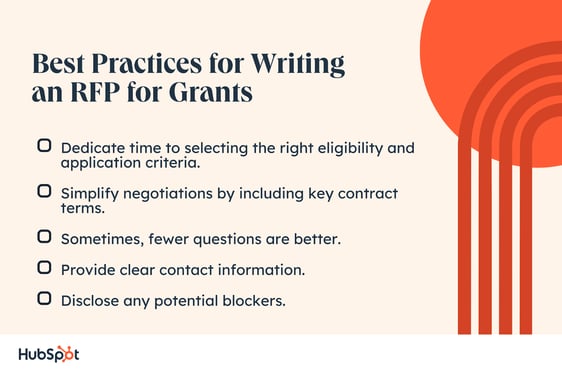
Dedicate time to selecting the right eligibility and application criteria.
This is, arguably, the single most important section of your RFP — perhaps even more important than “budget,” as NGOs will want to quickly assess their eligibility.
Esther Strauss, co-founder of Step by Step Business, agrees:
“Given the diversity of causes we support, from education to environmental conservation, finding a grant that provides the necessary funding and also aligns with our goals can be like searching for a needle in a haystack.”
Strauss says that, whenever applying for a grant herself, she needs to know if her organization can genuinely meet the grantor’s requirements while staying true to the organization’s objectives and values.
The need to get the application “right” can also extend to selecting the right application format or method. “The pressure to get it right is immense, as these grants can significantly impact our ability to serve our community,” she adds.
So, how can you make it easier for applicants to assess if they’re the right fit and avoid application mistakes?
Include clear information like:
- Only bidders who meet at least X out of Y criteria will be considered.
- Proposals must be sent in [FORMAT] by [DEADLINE]. Applications sent in through other channels will not be considered.
- Application needs to include a proposed schedule.
- Proposals must be shorter than [NUMBER] pages. Failure to comply with this guideline will result in an automatic rejection.
For a real-life example, you can also look at this RFP proposal from the U.N., which keeps the requirement descriptions clear and concise.
As you can see, the quality of the proposals and organization fit lies largely in your hands.
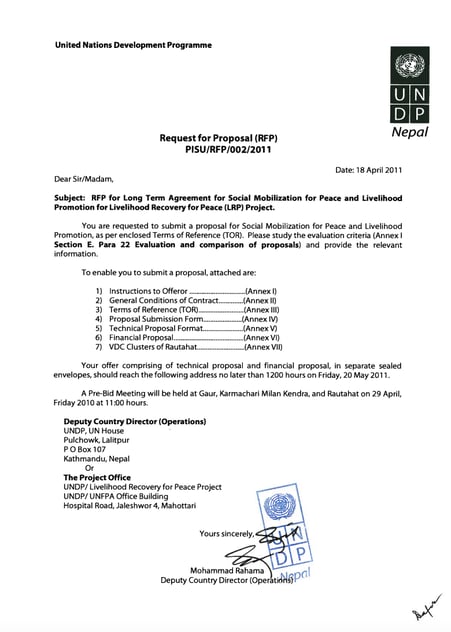
Image Source
Simplify negotiations by including key contract terms.
Earlier, I’ve mentioned that many RFP grant writers struggle with translating legal requirements in the RFP.
Wayne Tung of Sendero wrote a great piece on this subject, encouraging RFP publishers to give it the same level of attention as requirements and scope.
“Many people do not include contract term requirements, such as legal and commercial terms, in RFPs. This results in prolonged negotiations,” or even failed grants, he says.
Featuring the main contract terms in the RFP shows respect for both parties — you as the project operator and the organizations seeking funding.
Sometimes, fewer questions are better.
I spent quite some time going through Reddit threads popular among the RFP community, and one of the most interesting points I’ve seen was about question-fit.
One Redditor, roger_the_virus, blatantly says grantors should avoid “useless questions that won’t provide helpful answers. I do my best to make sure we’re not asking for a bunch of information we don’t need and won’t do anything with.”
That said, when it comes to questions, don’t automatically discredit applicants who can’t answer all of them. Offer organizations that have pitched a fitting project and budget the opportunity to ask follow-up questions.
This will prevent them from submitting answers with low informational value, i.e., responses that are vague or unrelated to your query.
Speaking of supplementary questions, this leads to the next point.
Provide clear contact information.
The larger your organization, the less likely it is that there will only be one person responsible for proposal reception and answering questions from applicants.
However, even if it’s an entire office, you should provide contact information with the relevant communication method — either walk-ins between a specific time, like Monday to Friday, email address, or phone number.
Bear in mind that many nonprofits apply to RFPs ongoingly and will only do so if they see that the grantor can help with applicant requests. Here’s an opinion on Reddit from an RFP proposal writer, which garnered multiple upvotes:
“I won’t respond to an RFP unless they commit to giving me their time for detailed discovery and a chance for them to read me the RFP requirements line by line and why they’re important.”
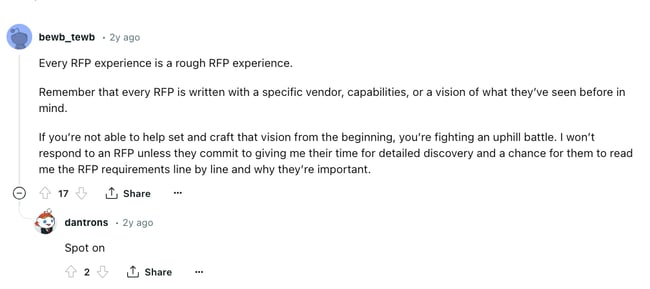
Image Source
Disclose any potential blockers.
Finally, be transparent about any potential roadblocks winning bidders might come across.
When applying for grants, NGOs need to know if they have the means to complete the project and if there are any other issues, like conflict of interest.
For example, say your organization wishes to assign funds to boost literacy rates in remote rural areas. One of the prerequisites could be having established relationships within target communities.
Such an approach will help preselect applicants, particularly those who don’t have the operational capacity to navigate around any potential constraints.
RFP for Grants Resources
Here are three resources that might come in handy while drafting an RFP for grants.
1. Candid’s Foundation Directory
Candid’s Foundation Directory shares essential information to help you make smart and strategic funding requests. These resources and tools give you access to funding opportunities that go beyond RFPs.
It includes a list of foundations, including their profiles, funding priorities, application procedures, and contact information.
RFP writers can go through the proposals that have been published already and use them as inspiration to create their own.
2. Free RFP Templates From HubSpot
HubSpot’s Free RFP templates are a great starter kit and will help you draft your request in no time.
This resource gives you two RFP versions — a shorter one and a longer one. Both documents are fully customizable, allowing you to easily add your company name and logo.
You can download them in PDF or turn them into a Microsoft Word or Google Docs file.
These templates include all the crucial elements of an RFP, such as:
- Company name and background.
- Project goals.
- Expected project timeline.
- Submission requirements.
- Evaluation criteria.
- Potential roadblocks.
Each section comes with a quick explainer to help you get the contents right.
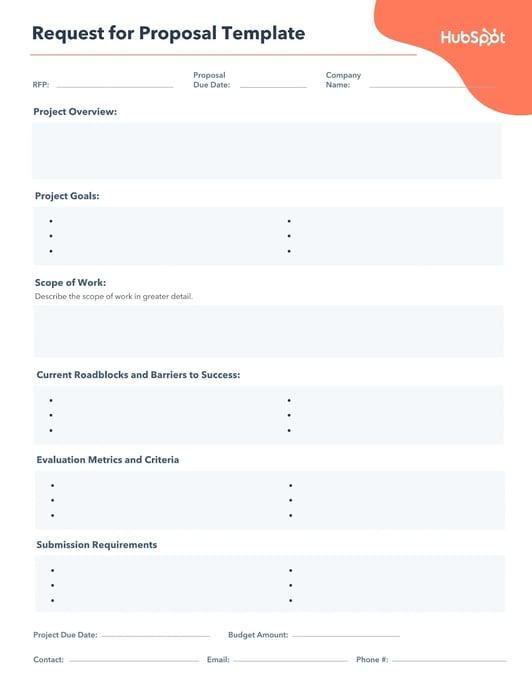
Download HubSpot’s RFP Templates for Free
3. Reddit – RFP Subreddits
Unsurprisingly, Reddit is one of the best places to learn from RFP experts as well as understand the applicant’s perspective.
I especially recommend following the RFP subreddit and navigating into more intricate conversations and topics from there.
While many of the discussions cover not only grants but also commercial projects, the advice is universal.
It also goes without saying that you shouldn’t just lurk around the corner — if there’s a challenge you’ve come across while drafting your RFP, this is the community you should ask for advice.
Getting Your RFP for Grants Right
Writing the RFP is the first — and arguably — most important step in the entire grant process. How so? It’s up to you as the grantor to select the right questions and criteria and explain the purpose of the project.
Remember, the more information you provide potential applicants, the easier it will be for them to assess if they fit the grant objectives. And this, in turn, will lead to a higher quality of proposals.
While there isn’t a one-size-fits-all template for each project, there are certain must-have sections to include. So, refer to this article to get a head start next time you need to create an RFP for grants.
Good luck!
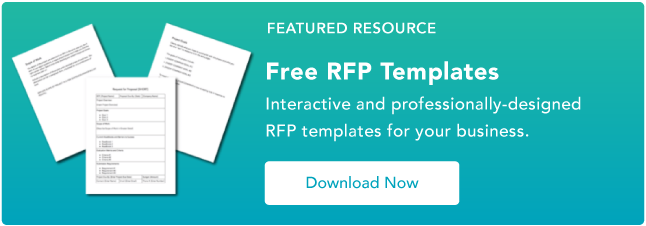
![]()
If Hubspot is of interest and you'd like more information, please do make contact or take a look in more detail here.
Credit: Original article published here.
